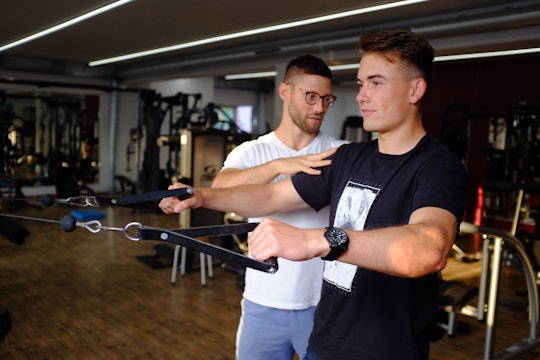
deeeds through Pixabay

Produced in partnership with TEDMED
Exosuits can restore mobility in stroke patients and soldiers alike
And they're customizable for different types of bodies, gaits, and speeds
There's been a bevy of heavy metal, superpower-imbuing robotic suits in pop culture — think Halo, Avatar, or Iron Man. In fact, these fictional portrayals were what inspired researchers at Harvard’s Wyss Institute in the Biodesign Lab to develop a new exosuit.
Initially, the goal of the exosuit project was to develop military applications. (Not surprising, considering the project was funded primarily through DARPA.) The researchers combined traditional robotics with flexible fabrics and lightweight parts, resulting in a soft, wearable design.
The scientists realized this technology could also be a medical tool. Kathleen O’Donnell, a staff industrial designer at Harvard’s Wyss Institute, met with clinicians and quickly honed in on stroke patients, who often suffer from weakness and loss of control in one side of their body. O'Donnell's team envisioned designing a suit that could be attached around the waist and calf, to help stroke patients balance their strides, reducing the effort it takes to walk. Volunteers were soon recruited as study participants, and a team of roboticists, industrial designers, control engineers, and physical therapists began designing, testing, and iterating the suit.
The team quickly faced several major challenges. “We have algorithms that measure the way you walk and try to predict when are you taking a step so that we can time the assistance,” explains O'Donnell. This kind of responsive assistance was easy to control in soldiers, since they tend to walk with symmetric, regularly-paced strides. But stroke patients tend to walk with different compensations and irregularities.
“Everybody walks a little bit differently after their stroke. They have different compensations they may use. One person might hike their hip up as they’re walking. One person may swing their leg around as they’re walking,” says O'Donnell. “We had to understand how to ignore [the compensations] to some extent, but still get the information that we needed about their gait to time the assistance with their particular gait pattern.” This personalized capability required the team to build adaptable algorithms that adjust the suit's required assistance with every step. The resulting exosuit never imposes how to walk — it just helps the patient walk naturally.
Another major difference between soldiers and stroke patients is body type. While it’s easier to design for the typically fit physiques of soldiers, stroke patients' physiques vary widely. Since the suits need to attach closely to a patient’s body, individual body types can significantly change the design of the suit. O'Donnell explains, “From an apparel design side, understanding both the range and mechanisms we were using to attach [the exosuit] as securely as possible to the patients became more challenging.”
With a diverse group of patients, the team built a toolbox of strategies to individually fit an exosuit to every user. During one testing and recording with a patient, O'Donnell describes the patient's transformation as dramatic. “Her foot looked so much more confident, so much more stable. She was able to stand up straighter.” While she acknowledges that fitting the suit required time, even without any optimization, the change in patients was frequently instantaneous.
From the beginning, O'Donnell and her team focused on patient volunteers who had experienced strokes and could immediately benefit from the exosuit. “It has been such an amazing process to work with all these volunteers from the community,” says O'Donnell. “Our first volunteer is still one of the volunteers who comes in, five years later.” Licensing the technology from the Wyss Institute, O'Donnell guided the transition of the exosuit and began to manage clinical trials in the hopes of making the suit available to the millions of stroke patients in the United States today.
So far, the exosuit has been tested on more than 40 patients. Of course, there will be potential challenges in scaling the technology. “We have made as much of an effort as possible to get as diverse a range of patients as we can. That includes body sizes and types, walking speeds, [and the] types of assistive devices they use,” O'Donnell says.
Giving freedom back to stroke patients is just the beginning. O'Donnell says the exosuit could help many other kinds of patients too. Other injuries or disorders are also on their minds. “We are starting in stroke, but we could potentially see suits for MS [multiple sclerosis] or suits for Parkinson’s.” With the ability to quickly alter and control the assistance, the exosuits could help people undergoing physical therapy by providing assistance when needed and taking it away to help rebuild strength. On the other side of the spectrum, the exosuit could be used at home to provide general, consistent assistance. Luckily, being made out of fabric helps reduce the overall cost of the exosuit. The possibilities for exosuits in medicine will be exciting to watch.
